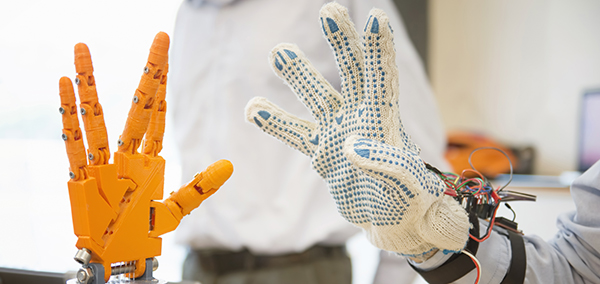Flexing towards the final frontier
Bendable and transparent, flexible sensors could bring electronics into the multibillion-dollar medical device and athleisure industries.
The electronics and microchips that have enabled the information revolution may have found their way into everything from toys to tech gadgets, but their hard and metallic nature have kept them away from the final frontier: the human body.
Sensors that measure everything from heart rate to blood pressure could go a long way in personalising healthcare for an individual, yet most existing medical sensing devices are external and only capture readings at a single point in time. For sensors to make a difference, they need to be small, light and most of all, flexible.
This is where flexible sensors—and their enabling technologies—come in. The following three technologies are making the most of flexible sensor technology to meet the needs of industries ranging from medical devices to athleisure.

Wearing Your Sensor on Your Sleeve
The e-textile industry, which is poised to be worth close to US$3 billion by 2026, rests on the premise that it solves many issues that wearable tech faces today. If it succeeds, today’s smart watch could well be replaced by smart t-shirts.
To reach their full potential, wearable devices should ideally be networked so that they can communicate and build up a comprehensive picture of what they are collectively sensing. However, wireless networks for wearable devices are currently limited by signal interference and weak security protocols, which hamper a wider adoption.
To get around this problem, this e-textile technology uses wireless signals that are propagated on the surface of the textiles rather than onto the surrounding space. This is achieved by confining the radio-waves to the clothing by way of patterns woven using conductive materials to create a metamaterial textile. By modifying the geometry of the metamaterial textiles, users can control the transmission of wireless signals or even sensing or signal processing devices,
With the athleisure industry booming and overtaking the denim industry, e-textiles such as these could profoundly influence sporting wear in the future. And it’s not just for fun and games; the technology can also be adapted for use in healthcare where vitals of patients can be monitored at all times through their clothing.

Access at Your Fingertips
From tracking our heart rate to our sleep patterns, sensors that are built into wearables strive to make life simpler. Take this tactile sensing glove, for instance. Studded with an array of tactile sensors, the glove responds to the slightest pressure of your fingers and translates it into a sense of touch.
The glove detects pressure using a layer of sensors that convert mechanical strain into a change in electrical resistance, which is an effect known as piezoresistance. It translates increased pressure into decreased electric resistance, which can be the stimulus to generate haptic feedback to the user.
Weighing under half a kilo and entirely customisable, the glove can easily be fitted onto robotic gripper or a prosthetic device. It can also be used in situations that demand tremendous precision, like surgeries or bomb disposals, since this technology enables sharpened sensory perception.

Putting the Pedal to the Metal
Whether they are worn as a clothing item or glove, all flexible sensor technologies require electrodes to supply power to its electronic components. This final technology—a novel metallisation platform—is thus a key enabler of wearables as a whole, allowing items of almost any shape to incorporate flexible electrodes.
By using proprietary inks based on gold, silver, platinum and palladium, as well as an energy efficient process, this technology enables transparent conductors and printed circuitry on a wide range of surface materials. These high performance metallisation inks are not only cost effective but also environmentally friendly.
The resulting electrodes are flexible and bendable, which are vital features for touchscreens and wearables. Best of all, this technology produces electrodes that are five to ten times cheaper than similar ones available on the market.

